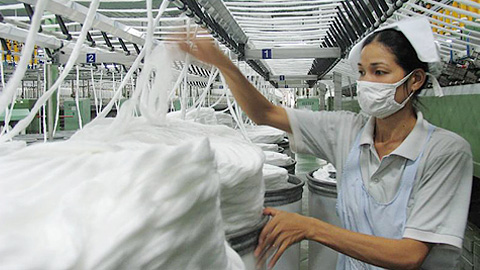Domestic cotton source yet to grow up for local fibre industry
 |
The country's cotton output meets only 2 per cent of domestic fibre enterprises' demand, the remaining 98 per cent was covered by import. The land area of cotton plantations is gradually receding because farmers seem to have accepted inferiority in this segment.
According to statistics compiled by the General Department of Vietnam Customs, in the first three quarters of this year, Vietnam spent $1.245 billion to import 787,000 tonnes of cotton. The figure is expected to reach $1.6 billion by the end of the year. In September alone, despite a light decrease compared to the monthly average, the total volume stood at 75,400 tonnes.
During the nine months of this year, Vietnam imported cotton from 11 countries. The US is the largest cotton supplier, providing 50 per cent of the total cotton import volume, equalling 400,000 tonnes and worth $635 million. The runners-up are India with 90,100 tonnes (worth $131.3 million) and Australia with 68,000 tonnes (worth $119 million).
Phan Tien Dung, director of fibre factory Vinatex’s Nam Dinh branch, domestic cotton does not meet the domestic industry’s quality and quantity requirements, forcing all domestic fibre factories in general and Vinatex’s fiber factory in particular to look for foreing sources.
Along with the usual risks associated with dependence on import materials, domestic fibre enterprises face the risk of missing delivery times or a strong change in material prices when they import cotton from the US, South Africa, and India.
According to Jonathan Devine, senior economist at the Corporate Strategy & Program Metrics Department at Cotton Incorporated, in 2016, fibre enterprises have seen continuous fluctuations in material prices due to numerous reasons, including unstable material sources. Unreasonable price swings will impact enterprises’ decision to continue to buy cotton. Meanwhile, unstable material sources can cause serious delays in delivery, impacting enterprises’ reputation.
However, according to a representative of a fibre enterprise in Thai Binh Province, the Vietnamese fibre industry is on the upswing, generating larger appetite for cotton. In the context of a lack of domestic cotton suppliers, imports will continue to be the major source, despite risks of delivery time, low quality, as well as shifting material prices.
In Mid-October, Vietnam’s fiber industry met a break-down on importing cotton. Notably, the Ministry of Agriculture and Rural Development issued a decision on halting raw cotton imports from Ghana.
The decision was made after a large volume of raw cotton was found infected with living khapra beetles (Trogoderma granarium Everts).
The decision will come into effect 60 days after the October 11 issuance.
The Plant Protection Department’s representative said, from July 2 to September 26, relevant authorities detected 58 containers of raw cotton, weighing more than 1,384 tonnes, imported from Ghana via Haiphong port to be infected with the very dangerous beetle not native to Vietnam.
A khapra beetle infestation can cause serious damage to various kinds of agricultural products, such as cereals, vegetables, and rubber. It is considered one of the 100 worst invasive species in the world.
| RELATED CONTENTS: | |
| Vietnam halts Ghana cotton imports | |
What the stars mean:
★ Poor ★ ★ Promising ★★★ Good ★★★★ Very good ★★★★★ Exceptional
Latest News
More News
- Businesses ramp up production as year-end orders surge (December 30, 2025 | 10:05)
- Vietjet chairwoman awarded Labour Hero title (December 29, 2025 | 13:06)
- How to unlock ESG value through green innovation (December 29, 2025 | 10:03)
- AI reshapes media and advertising industry (December 29, 2025 | 08:33)
- FPT and GELEX sign deal to develop blockchain tech for global markets (December 29, 2025 | 08:29)
- Vietnam’s GDP forecast to grow by 9 per cent in 2026 (December 29, 2025 | 08:29)
- Women entrepreneurs are key to Vietnam’s economic growth (December 29, 2025 | 08:00)
- Vietnam's top 500 value-creating enterprises announced (December 27, 2025 | 08:00)
- The PAN Group shaping a better future with ESG strategy (December 26, 2025 | 09:00)
- Masan Consumer officially lists on HSX, marking the next phase of value creation (December 25, 2025 | 13:20)















 Mobile Version
Mobile Version